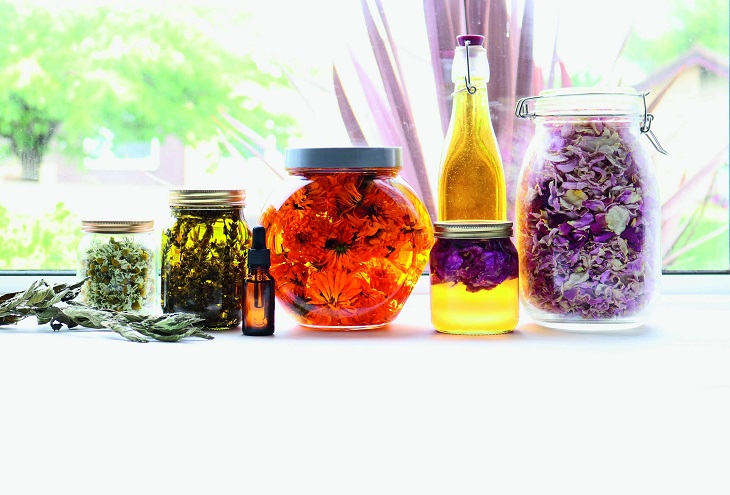Want to create your own bath fizzers, soaps and other skincare favourites with botanicals from your own garden?
If you grow roses, chamomile, lavender and other common plants, you can use them in your regular skincare routines, says Tanya Anderson, organic gardener and author of A Woman’s Garden: Grow Beautiful Plants And Make Useful Things, a guide to how you can use your garden plants to aid wellbeing.
“We tend to think of botanicals as plant extracts that come prepackaged, but the truth is that you can transform chamomile, roses, lavender, and even more exotic plants, into high-end skincare in the average kitchen,” she insists.
“You don’t need a huge amount of space,” she continues. “You can grow plants in pots or window boxes, or even forage for plants such as chickweed.”
Read: The beauty benefits of seaweed
Which plants should we grow for skincare?
Cucumbers are a soothing astringent, the roots of echinacea can be made into a tincture or glycerite, which is beneficial for healing skin, while soaking the roots of marshmallow in water can provide a cooling and hydrating infusion for the skin, she says.
Rosemary, thyme, violet and peppermint also have beneficial properties for skin, she adds.
Anyone with an indoor space could grow an aloe plant, for the obvious benefits the gel from a leaf can provide to soothe sunburn or regenerate tired skin.
“Different plants have different functions for your skin. Some promote healing, so if you have eczema or acne, it can help create regenerative tissue. Other plants have properties which make them humectant (which can draw moisture from the air).
Read: Everything you need to know about marshmallow skincare
“Some plants have natural tannins that help to tighten skin, so you can use them as toners. Witch hazel, for instance, has tannins in it. You use the extract in firming lotions and creams.
“If you’re a beginner, I’d grow gentle plants that are also edible. Chamomile, for instance, is fantastic for regenerative skincare, as is calendula. They can both be used as edible flowers, in calming tea, or in skincare.”
What about carrier oils?
To make herbal oils, you’ll need a carrier oil suitable for your skin type, she says.
“My favourite carrier oil is sweet almond oil, which is popular when used in massage. Those on a budget might use extra virgin olive oil, if your skin isn’t too oily.
“Coconut oil is good for your skin but can cause breakouts if you use it on your face – but we all have different skin types, so it’s a matter of trial and error and research.”
Projects to try
Create herbal oils

To do this, steep dried plant material in a carrier oil and you’ll end up with a solution that may be coloured or scented, which will contain fat-soluble components from the plant, she says.
The oil can be made by filling a jar halfway with dried plant material – such as calendula flowers – and then fill it up with a light carrier oil, such as sweet almond or grapeseed.
Leave it for two to six weeks in a warm spot out of direct sunlight, strain through a sieve and the finished product can be used to make massage oil, salves, lotions and cleansers.
Rose petal facial mist

“This is an easy one. To make the rose petal skin toner, you make a glycerite (from vegetable glycerine, which you can buy, and distilled water) and infuse those rose petals into it.”
Add that to a rose tea infusion, made by putting rose petals into distilled scalding water and then turning off the heat, putting a lid on the pan and allowing them to steep for 20 minutes, she advises.
“Shake it all together in a spray bottle. It’s a very light astringent which smells lovely, and the vegetable glycerine helps to promote moisture. Use it any time, but make a small amount, because it doesn’t last very long. Keeping it in the fridge will help it last longer.”
Herbal bath fizzers

“These are among the easiest things to make – and make great gifts. You combine bicarbonate of soda with citric acid and Epsom salts and then meld them together with herb-infused oil with dried herbs in it. It’s very safe and you can make it with the kids.
Read: Long-lasting beauty treatments to do at home
“The fizzers have infused oil in them. The fizziness is just for fun but the oil will float to the surface of the bath water and when you get out of the bath, that layer of oil will coat your skin and help to condition it afterwards.”
Easy soap

“If you are going to make soap from scratch, it is home chemistry, but you can buy pre-made organic ‘melt and pour’ soap bases, which you can cut into cubes and microwaved, and once it’s liquefied then you can add an infused oil and dried herbs afterwards.
“You have to work quickly, pour it into moulds and it will firm up.”
A Woman’s Garden: Grow Beautiful Plants And Make Useful Things by Tanya Anderson is published by Cool Springs Press, available now.
How many of these plants do you already grow? Why not share the first project you’re going to try with our readers in the comments section below?
– With PA
If you enjoy our content, don’t keep it to yourself. Share our free eNews with your friends and encourage them to sign up.

